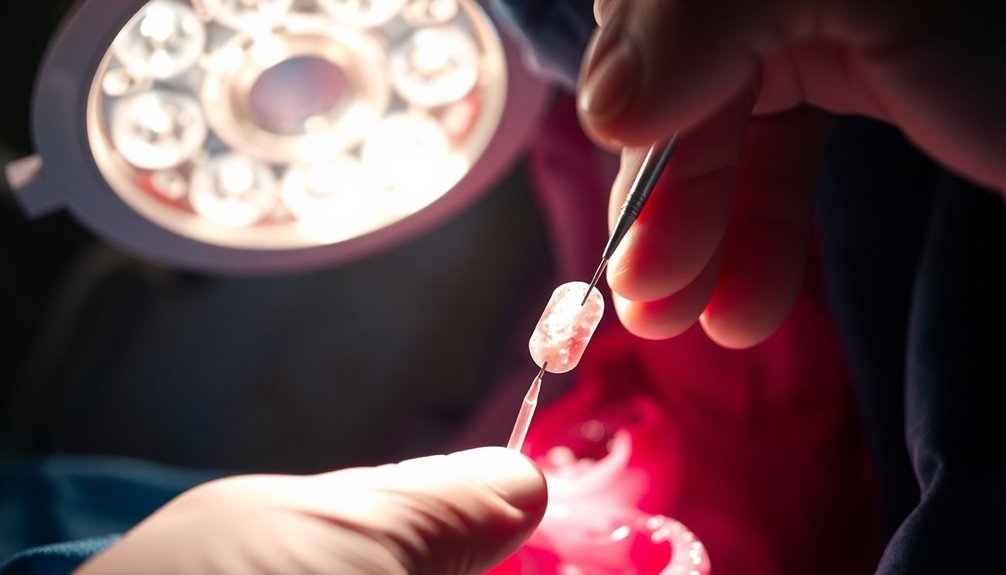If you're facing the shocking reality of Dilation and Curettage (D&C), know it's often necessary to remove uterine tissue due to serious issues like abnormal bleeding or miscarriages. The procedure's quick, lasting only about 10-15 minutes, and mild cramping afterward is normal. While there are risks, understanding what to anticipate can ease your worries. There's much more to reflect upon about the D&C process and recovery, so stay tuned for important information you'll want to know.
Key Takeaways
- D&C is a surgical procedure to remove uterine tissue, addressing issues like abnormal bleeding, fibroids, and complications from miscarriage.
- The procedure usually lasts 10-15 minutes under anesthesia, involving dilation of the cervix and scraping or suctioning the uterine lining.
- Patients may experience mild cramping and light spotting post-procedure, typically manageable with pain relief.
- Risks include uterine perforation, cervical damage, and potential development of Asherman's syndrome affecting future fertility.
- Follow-up care is essential to monitor recovery and discuss results, as well as future family planning options.
Understanding Dilation and Curettage (D&C)

Dilation and Curettage, or D&C, is a common surgical procedure that involves dilating the cervix to remove uterine tissue. This procedure typically lasts about 10-15 minutes and can effectively address issues like abnormal bleeding or complications from a miscarriage.
During the D&C, your healthcare provider uses a curette or suction device to scrape or suction the lining of the uterus after the cervix is dilated. Although post-procedure recovery is usually swift, with most patients resuming regular activities within 1-2 days, you may experience mild cramping and light spotting as side effects.
While risks like perforation of the uterus or cervix damage exist, they're rare. Overall, D&C is a safe option for managing uterine health concerns.
Reasons for Undergoing D&C

There are several reasons you might need to undergo a D&C, particularly if you're dealing with abnormal uterine bleeding or other reproductive health issues.
This procedure helps diagnose and treat conditions like fibroids or polyps that can cause heavy menstrual bleeding.
After a miscarriage, a D&C is often necessary to remove retained tissue, preventing complications such as infection.
If a pelvic exam reveals abnormal cells, a D&C can provide essential tissue samples for further analysis.
Additionally, in cases of molar pregnancy, where abnormal tissue grows in the uterus, curettage is vital to eliminate the tumor-like tissue.
The D&C Procedure: What to Expect

If you and your doctor have decided that a D&C is the best option for your situation, it's helpful to know what to expect during the procedure.
A D&C typically lasts about 10-15 minutes. First, your doctor will use instruments or medication to dilate your cervix. Then, they'll use a curette to scrape or suction the uterine lining, removing the necessary tissue.
You'll receive anesthesia to keep you comfortable throughout the process.
After the procedure, you may experience mild cramping and light spotting as part of your recovery.
It's important to follow up with your healthcare provider to discuss any biopsy results and plan for any further treatment if needed.
Recovery Process After a D&C

After your D&C, you'll spend a few hours in recovery to guarantee you're stable and watch for any complications.
You might experience mild cramping and light spotting, but over-the-counter pain relief can help.
It's important to monitor your symptoms and follow your healthcare provider's guidelines for your recovery.
Normal Recovery Expectations
While most patients can expect a smooth recovery following a D&C procedure, understanding what to anticipate during this time can help ease any concerns.
Your recovery time usually includes a few hours in a monitored setting before heading home, with many resuming normal activities within one to two days.
Common post-procedure symptoms may include mild cramping and light spotting, which you can manage with over-the-counter pain relief like ibuprofen.
It's important to avoid vaginal intercourse, tampons, and douching until your healthcare provider gives the green light, typically around two weeks later.
Don't forget to attend your follow-up appointments to discuss biopsy results and monitor your menstrual cycles, which generally resume within 2-6 weeks after the procedure.
Signs to Monitor
Monitoring your recovery after a D&C is essential for guaranteeing a smooth healing process.
Keep an eye out for heavy bleeding, as this may indicate complications and should be reported to your healthcare provider immediately. Mild cramping and light spotting are common, but over-the-counter pain relief, like ibuprofen, can help manage discomfort.
Your menstrual cycle may take 2 to 6 weeks to return, so any significant changes should also be discussed with your healthcare professional.
Avoid vaginal intercourse and tampon use until cleared to prevent infection and complications.
Watch for signs of infection, such as fever, chills, or foul-smelling discharge, and seek prompt medical attention if these occur to guarantee a safe recovery.
Risks and Complications of D&C

When considering a Dilation and Curettage (D&C) procedure, it's important to be aware of the potential risks and complications involved.
One concern is perforation of the uterus, which occurs in about 1-3% of cases and may need surgical intervention. You might also face complications like cervical damage, leading to cervical incompetence in future pregnancies.
There's a risk of developing Asherman's syndrome, where scar tissue forms in the uterus, affecting menstrual cycles and fertility in 10-20% of cases.
While infections are rare, they can occur in less than 1% of procedures and lead to serious issues if untreated.
Additionally, heavy bleeding can happen post-procedure, with 5-10% needing further medical evaluation for significant blood loss.
Hysteroscopy: A Complementary Procedure

When you're considering tissue removal from the uterus, hysteroscopy can be a valuable addition to the process.
This minimally invasive procedure helps your doctor visualize the uterine cavity, whether for diagnosis or to treat issues like polyps and fibroids.
Diagnostic vs. Operative Hysteroscopy
While both diagnostic and operative hysteroscopy play essential roles in evaluating and treating uterine conditions, they serve distinct purposes.
| Type of Hysteroscopy | Purpose | Procedure Details |
|---|---|---|
| Diagnostic Hysteroscopy | Identify structural abnormalities | Direct visualization with a hysteroscope |
| Operative Hysteroscopy | Diagnose and treat abnormalities | Remove tissue like polyps or fibroids |
| Minimally Invasive | Both procedures are minimally invasive | Typically performed in an outpatient setting |
| Timing | Often done after menstruation | Follow-up after diagnostic findings |
| Recovery | Quick recovery, resume activities | Usually within a few days |
You may find that diagnostic hysteroscopy helps visualize the uterine lining, while operative hysteroscopy addresses any abnormalities you may have.
Benefits of Hysteroscopy
Hysteroscopy offers considerable benefits as a minimally invasive procedure for diagnosing and treating uterine conditions.
You'll appreciate how this technique:
- Provides direct visualization of the uterine cavity, ensuring accurate diagnosis of abnormalities.
- Can be performed in an outpatient setting, allowing you to return to normal activities within a day or two.
- Reduces the need for multiple surgeries by simultaneously diagnosing and treating conditions.
With hysteroscopy, you'll experience less postoperative pain and lower complication rates compared to traditional surgeries.
Importantly, addressing uterine abnormalities can considerably improve fertility outcomes, helping those facing infertility or recurrent miscarriages.
Preparing for Your D&C

Preparing for your D&C is essential for guaranteeing a smooth procedure and recovery. Start by following your healthcare provider's instructions, which typically include fasting for several hours before the procedure.
Discuss your medical history, medications, and any allergies with them to guarantee safety.
On the day of the D&C, a speculum will be used to hold the vagina open, allowing access to the cervix. The cervix may be dilated with medication or laminaria for easier access to the uterus.
Since anesthesia affects your ability to drive, arrange for transportation home afterward.
Proper preparation will help you feel more comfortable and confident as you approach this important procedure.
Monitoring Post-Procedure Symptoms

After your D&C, paying attention to your body is important for ensuring a smooth recovery.
You'll want to monitor for any unusual symptoms, as they can indicate complications. Keep an eye out for:
- Heavy bleeding that soaks through a pad in an hour
- Fever or chills that may signal an infection
- Severe abdominal pain that doesn't subside
Mild cramping and light spotting are normal, but they should gradually lessen.
If you experience any of the aforementioned symptoms, contact your healthcare provider immediately.
Also, remember to avoid vaginal intercourse and tampon use until your healthcare team gives you the green light.
Staying vigilant about these signs will help you recover more effectively and protect your health.
Follow-Up Care and Future Considerations

While recovery from a D&C is often swift, follow-up care is vital to confirm your health and address any concerns.
You'll need to attend follow-up appointments to discuss your biopsy results and any next steps.
During recovery, monitor for warning signs like heavy bleeding, fever, or severe abdominal pain, and reach out to your healthcare provider if these occur.
Monitor for heavy bleeding, fever, or severe abdominal pain during recovery and contact your healthcare provider if any arise.
It's important to avoid vaginal intercourse, tampons, and douching until your healthcare team gives the green light, usually within a few weeks.
You can typically resume normal activities within one to two days, but recovery may vary.
Finally, discuss future family planning and timing for trying to conceive with your healthcare provider to confirm the best path forward.
Frequently Asked Questions
What Is the Removal of Tissue From the Uterus?
The removal of tissue from the uterus typically involves a procedure called dilation and curettage (D&C).
You'll find it's used to treat conditions like heavy bleeding or to clear out tissue after a miscarriage.
During the procedure, your doctor will dilate your cervix and use a tool to scrape or suction the uterine lining.
While risks exist, most people recover quickly, usually getting back to normal activities within a couple of days.
Do You Need Bed Rest After a Hysteroscopy?
You typically don't need bed rest after a hysteroscopy.
Most people can get back to their normal activities within a few hours to a day, depending on how you feel. Light bleeding and cramping might occur, but if they're mild, rest isn't necessary.
However, you should avoid strenuous activities and sexual intercourse for about a week to allow proper healing.
Always follow any specific care instructions your healthcare team gives you.
What Is Another Name for a D&C?
D&C, or dilation and curettage, is a delicate procedure often discussed in medical circles.
You might also hear it called "curettage," focusing on the tissue removal aspect. In some cases, it's referred to as "uterine evacuation," particularly after a miscarriage or abortion.
"Endometrial scraping" emphasizes the action of removing the uterine lining, and when paired with hysteroscopy, it's known as "hysteroscopic curettage."
Each term highlights a different facet of this important procedure.
How Long Does It Take for the Uterus to Heal After a Hysteroscopy?
Healing time after a hysteroscopy varies from a few days to two weeks, depending on the procedure's extent.
You might experience light bleeding and cramping during this period, which is normal.
It's best to avoid vaginal intercourse, douching, and tampons for at least a week to support recovery and minimize infection risk.
Most women return to regular activities in a few days, but those with more extensive procedures may need longer.
Conclusion
In a world where your health can feel like a rollercoaster ride, a D&C might just be the twist you didn't see coming! But fear not—this procedure can be a lifesaver, helping you reclaim your well-being. You'll bounce back stronger than ever, ready to tackle whatever life throws at you! So, embrace the journey ahead, stay informed, and remember: you've got the power to take charge of your health like a superhero!









